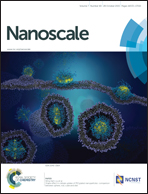Layer-separated MoS2 bearing reduced graphene oxide formed by an in situ intercalation-cum-anchoring route mediated by Co(OH)2 as a Pt-free electrocatalyst for oxygen reduction†
Abstract
A significant improvement in the electrochemical oxygen reduction reaction (ORR) activity of molybdenum sulphide (MoS2) could be accomplished by its layer separated dispersion on graphene mediated by cobalt hydroxide (Co(OH)2) through a hydrothermal process (Co(OH)2–MoS2/rGO). The activity makeover in this case is found to be originated from a controlled interplay of the favourable modulations achieved in terms of electrical conductivity, more exposure of the edge planes of MoS2 and a promotional role played by the coexistence of Co(OH)2 in the proximity of MoS2. Co(OH)2–MoS2/rGO displays an oxygen reduction onset potential of 0.855 V and a half wave potential (E1/2) of 0.731 V vs. RHE in 0.1 M KOH solution, which are much higher than those of the corresponding values (0.708 and 0.349 V, respectively) displayed by the as synthesized pristine MoS2 (P-MoS2) under identical experimental conditions. The Tafel slope corresponding to oxygen reduction for Co(OH)2–MoS2/rGO is estimated to be 63 mV dec−1 compared to 68 mV dec−1 displayed by the state-of-the-art Pt/C catalyst. The estimated number of electrons transferred during oxygen reduction for Co(OH)2–MoS2/rGO is in the range of 3.2–3.6 in the potential range of 0.77 V to 0.07 V, which again stands out as valid evidence on the much favourable mode of oxygen reduction accomplished by the system compared to its pristine counterpart. Overall, the present study, thus, demonstrates a viable strategy of tackling the inherent limitations, such as low electrical conductivity and limited access to the active sites, faced by the layered structures like MoS2 to position them among the group of potential Pt-free electrocatalysts for oxygen reduction.



 Please wait while we load your content...
Please wait while we load your content...